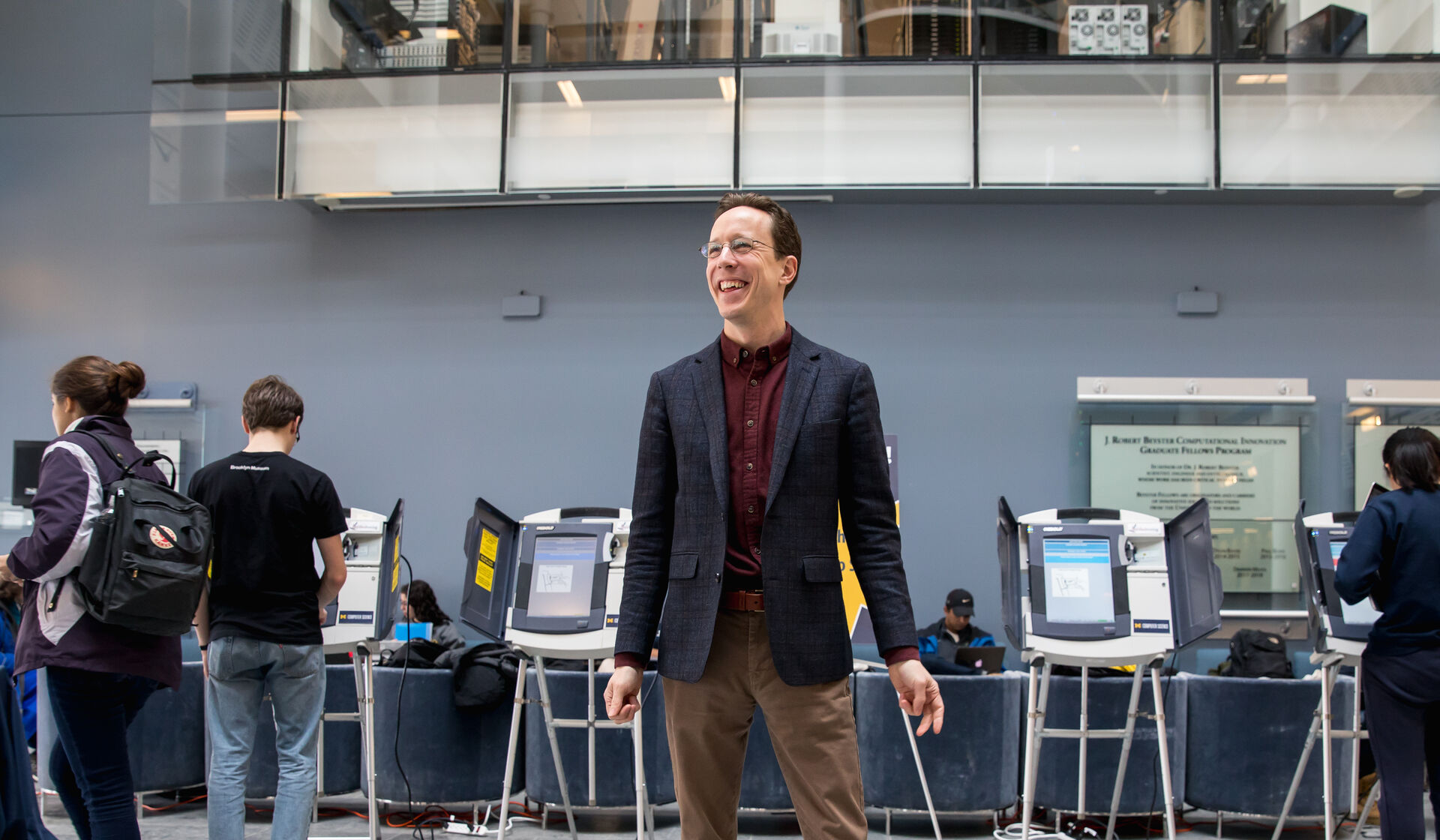This past winter, a national survey showed that one in three college students attending four-year institutions had trouble getting enough food to eat in the past year. U-M is now determined to help the hungry on its own campus.
Three years ago, when Nikki Kasper, ’06, MPH’09, PhD’15, was a doctoral candidate in U-M’s School of Public Health, she emailed a survey about food insecurity to 2,000 randomly selected students on campus. When the completed surveys began rolling in, Kasper realized the students’ experiences mirrored her own more than a decade earlier when she was an undergraduate.
One survey response read, “Aside from not being able to afford food, sometimes I find that to keep up with the rigorous academic demands and meet assignments, I must skip several meals in a day.” Another answered the question “What does food insecurity in college mean?” with the response “Hungry, frustrated, and unable to concentrate while studying or in class.” Yet another wrote, “I have gone two days without eating because I didn’t have food in my fridge.”
Published in 2016, Kasper’s study ultimately revealed that 41.4 percent of U-M students had low to very low food security, which the U.S. Department of Agriculture defines as a lack of consistent access to enough food for an active, healthy life. Kasper, who is now a postdoctoral fellow in the Department of Nutritional Sciences at the School of Public Health, also found that food insecurity correlated with a lower grade point average.
The problem of food access among college students is not unique to U-M. In April, the Wisconsin HOPE Lab conducted a national study of 43,000 students and found that 36 percent of four-year students reported struggling with food insecurity in the 12 months preceding the survey, 22 percent within the previous 30 days. Among students at two-year institutions, 35 percent had felt food insecure in the 30 days before filling out the survey.
“Combine an extremely challenging school schedule that does not allow you to work many hours; a lack of transportation, money, and knowledge about food prep and budgeting; and an inability to qualify for federal food benefits due to student status, and you have the recipe for a population with very high food insecurity,” says Kasper.
To that end, U-M is now working to assist food-insecure students through a number of programs and partnerships with existing campus organizations. “There are a lot of different reasons why a student experiences food insecurity,” says Sarah Daniels, associate dean of students. Daniels is part of a U-M administrative work group organized in the spring of 2017 by Vice President of Student Life E. Royster Harper to address the problem.
“Generally, we assist students who are experiencing a short-term situation that is impacting their ability to obtain food in a socially acceptable way,” says Daniels.
One new way U-M will help students during the fall 2019 semester is by launching a permanent food pantry that will operate 20 to 25 hours a week. It will be located on Central Campus, though at press time the location had not yet been confirmed. Called Maize & Blue Cupboard, the permanent pantry expands an existing program with the same name that began in late 2014 and has been operating as a student-run, monthly pop-up food distribution center. Since January 2017, the pantry has been located exclusively in the Trotter Multicultural Center. (That building remains open while a new multicultural center is currently under construction.)
Maize & Blue Cupboard’s president, senior Dzenana Svraka, has long advocated for a permanent pantry open weekly, rather than monthly. On average, she says that 200 to 300 students attend each monthly food distribution. However, at the pop-up this past April, some 550 students took part while another 150 students had to be turned away. “There was not enough food available,” she says, even though they distributed their normal monthly food allotment of 3,000 pounds donated by the local charity Food Gatherers.
Though meal plans at U-M come in a variety of packages, not everyone can afford one, or even wants one, as plans are limited to meals in residence halls, campus cafés, and establishments who take “dining dollars.” The combined cost of room and board for students residing in residence halls, according to U-M’s Office of Financial Aid, is $11,534 per year. For students who live off campus, the most expensive meal plan is unlimited and costs $2,540 per semester; the least expensive, a limited meal plan, costs $690 per semester.
According to Steve Mangan, senior director of Michigan Dining, around 45 percent of undergraduates—roughly 12,000 students—have some type of on-campus meal plan, which leaves about 14,000 undergraduates cooking for thewmselves.
One way Michigan Dining benefits students not on a meal plan is by offering those who work in the dining halls (on average 1,500 to 1,800 students a year) a free meal during every three-hour shift. “It’s a great strategy for a student struggling with food insecurity,” says Mangan, who also serves on the University work group around food insecurity.
In February 2017, members of the Central Student Government (CSG) met with Mangan to ask if Michigan Dining could provide meal swipes to those without access to food. Mangan challenged them to do more research and think of a program that did not merely give away food but addressed the issue. “Food insecurity really isn’t a dining problem. It’s a societal problem. Just giving them a meal doesn’t fix anything,” he says.
The solution Mangan and the CSG students came up with was for food-insecure individuals to be connected to the Dean of Students Office. Once there, a student is given free-meal swipes and assistance from Daniels on ways to address the problems causing the food insecurity. The most common problems, she says, are a delay in receiving financial aid or scholarship disbursements, a medical emergency, and spending all earned money from a job on textbooks and other basic needs.
“These are just some examples,”Daniels says. She is hopeful that Maize & Blue Cupboard will be a connector to other resources on campus, linking students in need with the Office of Financial Aid. The pantry will also offer classes on healthy cooking and advise students on how to buy food on a budget.
What’s more, Maize & Blue Cupboard is just one organization in an umbrella group established in 2011 by U-M’s Sustainable Food Program (UMSFP), which bills itself as an initiative that “empowers students to create a sustainable food system at the University of Michigan while becoming change agents for a vibrant planet.” Its members also include the campus farm; the Ann Arbor Student Food Co., which runs a produce stand twice a week in Mason Hall; and the Food Recovery Network, which picks up leftovers from U-M dining halls and transports them to Food Gatherers. (The food is then redistributed to food pantries in Ann Arbor that serve the University population.)
Three weeks into the fall semester—at one of the last Maize & Blue Cupboard monthly pop-ups—it was clear a permanent pantry will be popular with students. After completing a brief questionnaire (the only requirement for gaining access to the pantry), students were filling their bags to the brim with fresh produce, peanut butter, apple juice, fresh bread, and pasta, all laid out on long rectangular tables.
U-M junior Ashley Duong, the daughter of Vietnamese immigrants and factory workers, was particularly grateful for her bag of groceries. She is the first in her family to attend college and though her tuition is funded by scholarships, she laments “everything else I pay for on my own.” On top of carrying an 18-credit course load, she works 30 hours a week. “It’s easy to rely on fast food, so this is a big help,” she said about herself and other first-generation students she knows who are struggling to support themselves.
One thing Kasper’s research showed was the need for an affordable, full-service grocery store within walking distance of campus. Currently, students who don’t have access to a car have little choice but to take a 30-minute bus ride to the closest supermarket. That requires time and money—two things many students do not have, particularly if they are working and their financial aid covers only tuition. What’s more, food prices in convenience stores within walking distance of campus are, on average, 86 percent higher per item than those not within walking distance, says Kasper. She adds that those stores located near campus often have lower-quality produce with a shorter shelf life.
Senior Connor Kippe, co-president of UMSFP, believes a nearby grocery store would provide a larger selection and reasonable prices for students. “It isn’t just about missing meals, but about eating meals that aren’t nutritious,” he says.
According to Kasper, a University-run grocery store would be in a better position to offer items at moderate prices within the students’ budget than a commercial grocery store, due to high rents in Ann Arbor. Says Daniels, “The pantry won’t be the end of the conversation, but hopefully the beginning of more. We want to think about where else we can influence this issue.”
CSG is also continuing to take a lead. It recently established an affordability task force to look into the issue. Mangan also remains optimistic. “We have the capability and the engagement. We’re getting all kinds of people interested in working with us. I think Michigan is up to the challenge.”
Julie Halpert, ’84, is a freelance journalist for publications including The New York Times, CNBC, Family Circle, and The Wall Street Journal. She also teaches journalism in U-M’s Program in the Environment.





